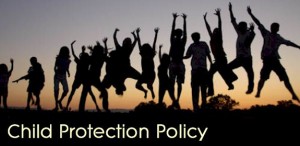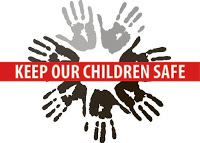Child Safety – Part 2: Planning & Creating A Child Protection Policy

This is the second in a series of three “Child Safety” posts focusing on the purpose, planning, creating and implementing of a Child Protection Policy (CPP).
Last week, in Part 1, we shared a quick look at the numbers, or abuse statistics, that support the need for every child-centered organization to have a CPP in place and the overall purpose that it serves.
This week we’re going to look at the process of planning and creating your own personalized CPP. It will be different for each organization, but we’ll share some particulars on how to get the process started and the items to take into consideration when designing a good policy.
To recap…a CPP is able to help ensure that anyone who comes into contact with children has a defined set of working principles and minimizes the grey area regarding interacting with kids. In addition, it provides another layer of protection for staff, volunteers, and adults against the scenario of false accusations. The purpose of a CPP is to create a safe environment for the children by focusing on decreasing isolation and increasing accountability.
Let’s Begin
So where do you start? What elements should your CPP include? The answer of course lays in the context of your situation. It’s important to note, that no single policy works well in every situation. Each policy is unique and takes into account factors such as organizational mission & vision, size, facility design, priorities, values, and goals for children’s ministry.
In writing your CPP, it’s important to strike a balance between being too general and including overly detailed policy statements. Keep in mind, some of the guidelines will not be specific to preventing abuse and will include general precautions such as protecting against illness, and allergy management procedures. The goal is to create principles that reflect your ministry’s values, while utilizing specific policy statements that include enough detail for staff and volunteers to understand how each principle relates to a specific situation.
By definition, a CPP is a policy manual. While it will have some general principles, the majority of its contents should be specific policy guidelines. The challenge comes with going to the extreme and trying to create a specific guideline for every scenario you can think of. Policies that are too long and detailed often cause frustration. On the other hand, you don’t want to create a few general guidelines and leave it up to the volunteers to subjectively figure out how it applies – this is a recipe for disaster.
Let’s look at an example of a general principle, and then consider a specific policy that stems from it. This illustration was taken from On Guard – Preventing and Responding to Child Abuse at Church by Deepak Reju. Using the statement of knowledge we’ve gained on how abusers work: “The risk of abuse increases when a child is isolated with an adult. Sexual offenders often commit abuse in private settings where there is no accountability.” If this statement was included in a CPP as a general principle, volunteers would have to figure out if they’ve isolated a child or not. The statement provides no associated classroom guidelines such as, “For all children’s classes and programs at least two qualified, nonrelated adult volunteers must be present in each classroom at all times,” or “When children’s programs or classes are in session, the interior doors and windows should allow for unobstructed views of the room.” Based on this example, it’s clear that providing detailed guidelines goes much further in reaching the goal of increasing safety and preventing abuse.
Next, let’s take a look at the topical pieces that create a good CPP. For the purposes of this post, highlighted will be some of the most vital elements as described in On Guard – Preventing and Responding to Child Abuse at Church. While the list doesn’t include every component, it will give you a sense of the fundamentals that should be well thought out.
Elements of a CPP
The Vision & Mission of Your Children’s Ministry: Vision statements should be easy to read and comprehend. They should articulate where your ministry fits into God’s overall plan for the little ones you serve. The mission statement should define how you’re going to accomplish your vision. These statements are important because they’re foundational pieces on which to build a solid CPP.
Parameters for the Policy: Indicate the scope of your plan. Meaning how it sets boundaries, establishes responsibilities for staff and volunteers, and sets up the procedures for how your guidelines will be executed.
Personnel Summary: Defines the roles and responsibilities of who participates in children’s ministry. This includes but is not limited to leadership, staff, volunteers, guardians, and parents.
Staff & Volunteer Expectations: Is a general section that calls out the expectations for those serving. For example, “All those working in children’s ministry will share the responsibility of loving, serving, and setting an example like Christ for the children.”
Screening Procedures: This is an important one and worth spending some time on. This section should include the following: How long should a person be a part of the church before he/she is allowed to serve with the children? What’s the minimum age of a volunteer? What types of volunteer training need to be completed before serving? What type of application is the volunteer required to fill out? Will the church conduct a background check – if so what kind; local, national (FBI finger print search) and how often? Will the church investigate the individual’s personal references and social media accounts? Who will conduct the personal interview? Who will make the final decision on volunteer approval?
Training & Education: Outlines the required training and education, for staff and volunteers that should be completed before serving. It should also include details of policy updates and reminders. This could include weekly, monthly, or quarterly meetings, get-togethers or actual trainings on procedure and policy.
Expectations for Classroom Procedures: Includes the two-adult rule, adult-to-child ratios, and guidelines for visibility, discipline, physical touch, and food/snack details.
Protective Rules & Safety Guidelines: As stated earlier, this section includes additional guidelines that will increase child safety, but might or might not specifically pertain to abuse prevention. Guidelines include but are not limited to Illness, Child Check-in/out Procedures, Restroom Procedures, Transportation Guidelines, Events – (on or off site), Emergency Response Plan, Abuse Prevention and Reporting and Response, Sex Offender Guidelines, and A Duty-to-Warn Policy.
On Guard – Preventing and Responding to Child Abuse at Church also suggests an appendix be added to include the following:
- Signs and symptoms of abuse
- Samples of children’s ministry forms such as incident reports, medical consent, transportation consent
- Screening application and background check form
- State guidelines for mandatory and permissive reports
Join us for Part 3 as we look at the final steps in the process of creating a good CPP. We’ll be sharing steps to write and implement your new plan.
To learn more about improving child safety, additional security tips, and best practices visit the KidCheck blog or connect with us on Twitter, Facebook, Google+, or Pinterest.
Sources: Enrichmentjournal.org, Techtarget.com, On Guard – Preventing and Responding to Child Abuse at Church by Deepak Reju



Defining, Creating, and Implementing a Child Protection Policy — INCM
28/02/2017 at 9:34 am
[…] take a look at Part 2 for the process of planning/creating a solid CPP and Part 3 about writing and implementing your […]